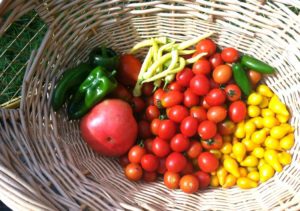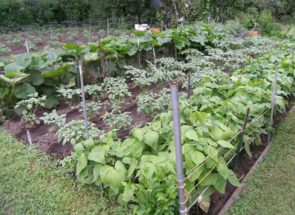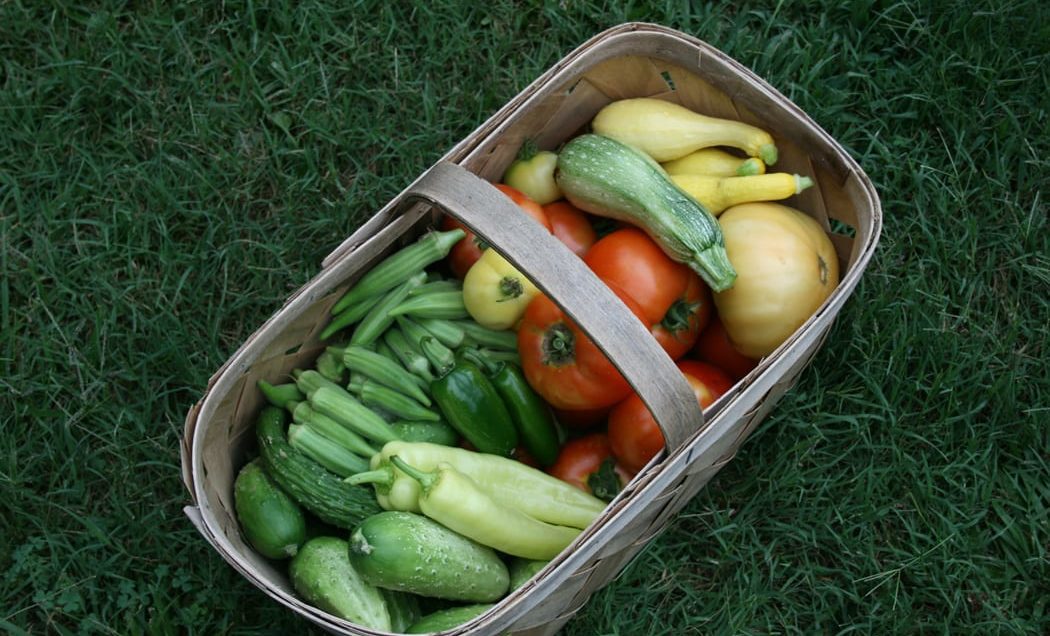Having fresh produce available at any time is easier when you can grab it straight from your own garden. Home gardening is not a new trend, but it’s continued to pick up steam in recent years, with the pandemic bringing a new level of interest to the subject. Everyone has the ability to plant a garden, regardless of space – an herb box makes for a perfect addition to any windowsill option. Vegetables can be grown in a variety of ways, from traditional in-the-ground planting and raised beds to pots and yes, even straw bales.

The first step to building the vegetable garden you’ve been waiting for is to start with a few basic questions:
Who will be doing the work (tending the garden)?
Will the garden be a group project with family members or friends who will work willingly through the season to a fall harvest, or will you be handling the hoe alone in between camping and swimming? Remember that a small weed-free garden will produce more than a large, weedy mess.
What do you (and your family) like to eat?
Although the pictures in the garden catalog look delicious, there is no value in taking up gardening space with vegetables that no one eats. Make a list of your family’s favorite vegetables, ranked in order of preference. This will be a useful guide in deciding how much of each vegetable to plant. Successive plantings of certain crops, such as beans, can be harvested over a longer period of time and increase your yield. As you plan, list recommended varieties and planting dates.
How do you plan to use the produce from your garden?

If you plan to can, freeze, dry, or store part of the produce, this will be a factor not only in planning the size of the garden but also in selecting varieties. Some varieties have much better keeping quality than others. Care should be used in choosing the seeds, making sure the varieties you select are adapted to your area and intended use.
How much space is available and what is proximity to water source?
How much area can be converted into usable garden space, and how much garden do you need? Do not plant more garden than you need.
How close is the water source? Make sure your garden has an accessible water source, whether you can set up irrigation or simply drag a hose over when the inevitable dry weather arrives.
Once you’ve answered the above questions and determined what you are going to plant, plan your garden out on paper before planting – showing the arrangement and spacing of crops, grouping plants by the length of growing period. Remember, place tall and trellised crops on the north side of the garden so they will not shade the shorter vegetables.
Now that you’ve planned out your garden, it’s time to plant. You can start with seeds or transplants (purchased at your local home and garden store), keeping in mind that you want to plant after the last freeze in your area.
Additional Tips:
– Keep your garden as small as possible to cut down on unnecessary work.
– Get a soil test to determine the nutrients in your soil. A fact sheet with details on soil testing can be found on the HGIC website.
– In South Carolina, gardens should receive at least six hours of direct sun each day (leafy vegetables can tolerate partial shade; vegetables that produce fruit, such as peppers and tomatoes, must be grown in full sun).
– Avoid planting your garden close to or beneath trees and shrubs because shade and the competition for nutrients and water may reduce vegetable growth.
– Plants grown for their leaves or roots can be grown in partial shade.
Planting Chart: Dates to plant in South Carolina
| CROP | COASTAL SPRING PLANTING DATE RANGE | coastal fall Planting Date Range | piedmont spring Planting Date Range | piedmontfall Planting Date Range |
|---|---|---|---|---|
| Asparagus | Feb 1 to Mar 15 | Not recommended | Mar 1 to Apr 15 | Not recommended |
| Beans, Snap | Apr 1 to Jun 1 | Aug 1 to Sept 1 | Apr 15 to Jul 1 | Jul 20 to Aug 1 |
| Beans, Pole | Apr 1 to Jun 1 | Aug 1 to Sept 1 | Apr 15 to Jul 1 | Jul 20 to Aug 1 |
| Beans, Half-Runner | Apr 1 to Jun 1 | Aug 1 to Sept 1 | Apr 15 to Jul 1 | Jul 20 to Aug 1 |
| Beans, Lima | Apr 15 to Jun1 | Jul 15 to Aug 1 | May 1 to Jun 15 | Jul 1 to Jul 15 |
| Beans, Pole Lima | Apr 15 to Jun1 | Jul 15 to Aug 1 | May 1 to June 15 | Jul 1 to Jul 15 |
| Beans, Edible Soy | Apr 15 to Jun1 | Jul 15 to Aug 1 | May 1 to June 15 | Jul 1 to Jul 15 |
| Beets | Feb 15 to Mar 31 | Aug 15 to Sept 30 | Mar 15 to May 31 | Jul 15 to Aug 31 |
| Broccoli 1 | Mar 1 to Apr 10 | Sept 1 to Sept 30 | Mar 20 to Apr 30 | Aug 15 to Sept 15 |
| Brussels Sprouts | Not recommended | Sept 15 to Oct 15 | Not recommended | Aug 15 to Sept 15 |
| Cabbage 1 | Feb 1 to Mar 31 | Aug 15 to Sept 30 | Mar 15 to Apr 30 | Jul 15 to Aug 31 |
| Cantaloupe | Mar 15 to May 15 | Jul 1 to Jul 30 | Apr 15 to Jun 5 | Not recommended |
| Carrots | Feb 1 to Mar 15 | Sept 1 to Sept 15 | Feb 15 to Mar 31 | Aug 1 to Sep 15 |
| Cauliflower 1 | Mar 1 to Apr 10 | Aug 15 to Aug 30 | Mar 20 to Apr 30 | Jul 15 to Aug 31 |
| Collards | Feb 1 to Jun 15 | Aug 1 to Oct 30 | Mar 15 to Jun 30 | Aug 1 to Sept 30 |
| Cucumber | Mar 15 to May 15 | Aug 1 to Aug 30 | Apr 15 to Jun 5 | Aug 1 to Sept 30 |
| Eggplant 1 | Apr 1 to Apr 30 | Aug 1 to Aug 31 | May 1 to Jun 30 | Not recommended |
| Garlic | Not recommended | Oct 1 to Nov 30 | Not recommended | Aug 15 to Oct 15 |
| Honeydew | Mar 15 to May 15 | Jul 1 to Jul 30 | Apr 15 to Jun 5 | Not recommended |
| Kale | Feb 1 to Jun 15 | Aug 1 to Oct 30 | Mar 15 to Jun 30 | Aug 1 to Sept 30 |
| Leeks | Feb 1 to Jun 15 | Not recommended | Mar 15 to Jun 30 | Not recommended |
| Lettuce 2 | Feb 1 to Apr 15 | Sept 5 to Nov 1 | Mar 1 to May 15 | Not recommended |
| Mustard 2 | Feb 1 to Jun 15 | Aug 1 to Oct 15 | March 15-Jul 30 | Aug 1 to Sept 15 |
| Onion, sets | Feb 1 to Mar 15 | Sept 15 to Nov 15 | Feb 15 to Mar 30 | Sept 15 to Oct 15 |
| Onion, plants | Not recommended | Oct 1 to Nov 15 | Not recommended | Sept 15 to Oct 15 |
| Onion, seeds | Not recommended | Sept 15 to Oct 30 | Not recommended | Not recommended |
| Okra | May 1 to Jun 30 | Not recommended | May 15 to July 15 | Not recommended |
| Peanuts | Apr 1 to May 31 | Not recommended | May 1 to Jun 30 | Not recommended |
| Peas, Garden | Feb 1 to Mar 15 | Aug 15 to Nov 30 | Mar 1 to Apr 5 | Aug 15 to Oct 30 |
| Peas, Southern | Apr 1 to Jun 15 | Jul 15 to Aug 1 | Apr 15 to Jul 15 | Not recommended |
| Pepper 1 | Apr 1 to May 15 | July 10 to Aug 10 | May 1 to Jun 30 | Not recommended |
| Potatoes, Irish | Feb 1 to Mar 31 | Not recommended | Mar 15 to Apr 30 | Not recommended |
| Potatoes, Sweet | Apr 15 to Jun 15 | Not recommended | May 1 to Jun 15 | Not recommended |
| Pumpkins | Not recommended | Jun 1 -to Jun 30 | Not recommended | Jun 15 to Jul 15 |
| Radish 2 | Feb 1 to Jun 15 | Aug 1 to Sept 30 | Mar 15 to Jun 30 | Aug 1 to Sept 15 |
| Rutabaga | Feb 1 to Mar 31 | Aug 15 to Oct 15 | Mar 15 to Apr 30 | Jul 15 to Sept 30 |
| Spinach 2 | Feb 1 to Apr 1 | Aug 15 to Oct 15 | Mar 15 to Apr 15 | Aug 1 to Sept 30 |
| Sweet Corn 2 | Mar 1 to Apr 15 | Not recommended | Mar 30 to May 31 | Not recommended |
| Squash, Summer | Mar 15 to Jul 31 | Aug 1 to Aug 31 | Apr 15 to Jul 31 | Jul 15 to Aug 15 |
| Squash, Winter | Mar 20 to May 1 | Aug 1 to Aug 31 | Apr 15 to Jun 15 | Not recommended |
| Tomato 1 | Mar 1 to Apr 30 | July 1 to Jul 31 | May 1 to Jun 30 | Not recommended |
| Turnips 2 | Feb 1 to Apr 1 | Aug 1 to Sept 30 | March 15-Apr 30 | Aug 1 to Sept 15 |
| Watermelon 1 | Apr 1 to Apr 30 | Not recommended | Apr 15 to June 15 | Not recommended |
2Sequentially plant to extend the cropping season
Get in touch and we will connect you with the author or another expert.
Or email us at news@clemson.edu

